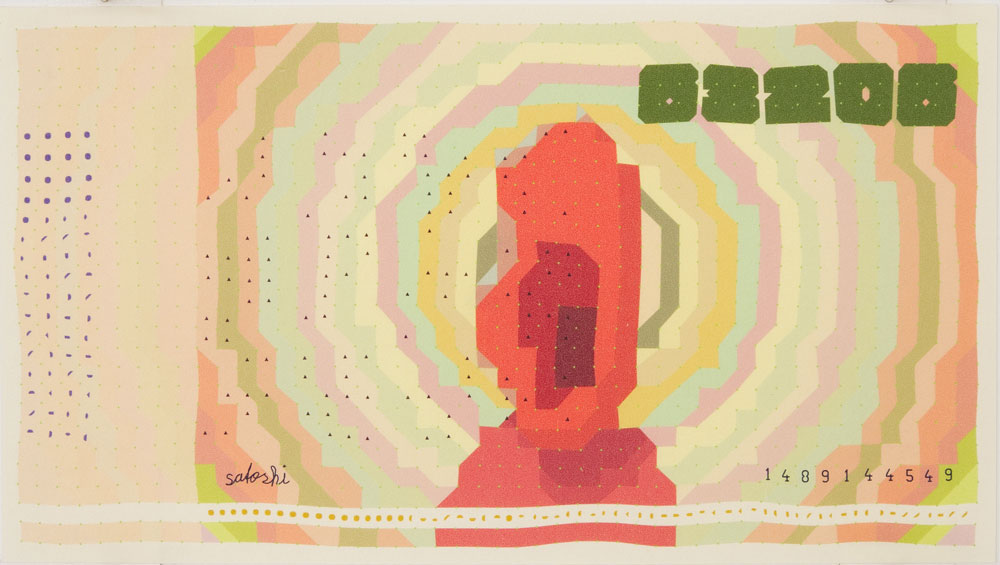
by VERONICA SIMPSON
Matthias Dörfelt (b1987, Hamburg, Germany) is a Los Angeles-based digital artist. His work, he says, is about “infusing technology with flaws, naivety and weirdness” to enhance its expressive capability.
His work interrogates our relationship with machines of all kinds - from guns to social media – and explores the grey area that the emerging digital art world inhabits within the art market. In 2015, he set up an online gallery, It’s Doing It, inspired by Hans Ulrich Obrist’s Do It: the Compendium, where computer-generated images were autonomously updated on a daily basis for 45 days. All the works in the show were instruction-based artworks from computer programs written by the exhibiting artists. It was listed as one of the top 10 works of internet art of that year by Hyperallergic magazine. This year, for Donald Trump’s inauguration, he created a Twitterbot: @WienerTrump, a wiener sausage with a Trump-like hairdo, whose randomly generated cartoon antics are posted daily.
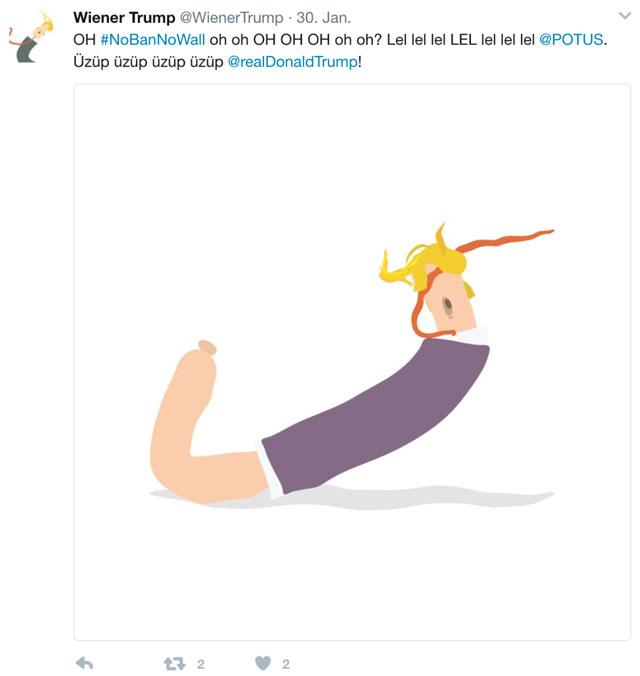
Matthias Dörfelt. Wiener Trump, 2017 (detail). A twitter bot (@WienerTrump) that started drawing self-portraits on Inauguration day, January 20th 2017 and will continue to do so every day for one year. Tweets that accompany the drawings are random loud noises that sometimes incorporate a popular hashtag of the day. © the artist.
Last month, he won the Lumen Prize Still Image Award for his Block Bills artwork, presenting 64 distinctive banknotes generated from the Bitcoin blockchain (a blockchain is a decentralised network that facilitates transactions between designated parties, outside the control or influence of any central ISP). Each bill features colourful patterns randomly generated by code. They are signed with the name Satoshi (the fictional name of the person or collective that invented the bitcoin), and the value represented on each note signifies how many times that particular block has been transferred in a given period. A shadowy interpretation of a face is placed where most notes would feature some heroic national figure.
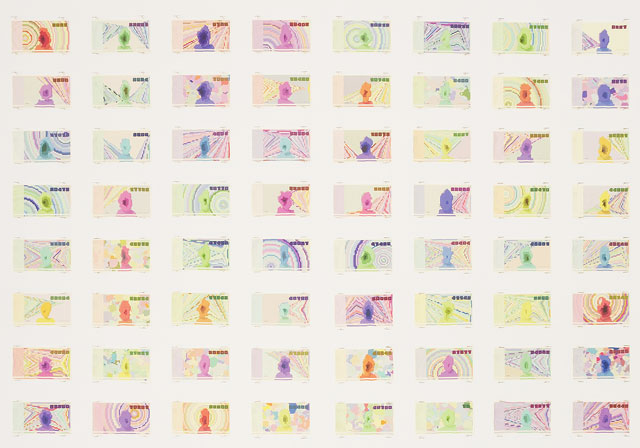
Matthias Dörfelt. Block Bills, 2017. A series of 64 banknotes generated from the Bitcoin Blockchain. © the artist.
Dörfelt studied communication design at the Muthesius University of Fine Arts and Design in Kiel, Germany, and then went on to UCLA for his MA in fine art. He now combines teaching in the design media arts department at UCLA, and at the University of Southern California, with his own digital art practice.
Veronica Simpson: What is your particular journey towards an art practice in which computer technology is integral?
Matthias Dörfelt: My undergraduate degree was communication design. In that field, code and generative approaches had a pretty big boost around 10 years ago, between 2005-10. I was going to some conferences and following things online, and I was kind of blown away by the possibilities. Just out of curiosity, I started to teach myself how to code. My first experiments were in processing, one of the early Java-based creative coding environments. At the time, I didn’t even know I was going to make fine art at some point, I was just curious and it became one of the two essential pillars of my practice.
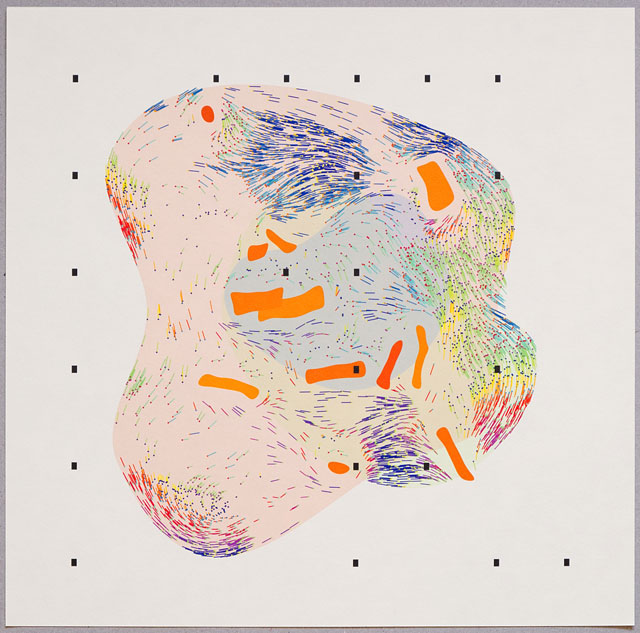
Matthias Dörfelt. Unnatural Flux, 2017. Archival digital print on paper. An ongoing series of computer generated drawings inspired by meteorologist maps and scientific visualisations of flow. © the artist.
VS: What or who inspired you to switch to fine art?
MD: At that time, I mainly looked up to designers working on huge commercial art and advertising installations. One person was Karsten Schmidt. He is German, but is now based in the UK. He worked with people such as Universal Studios and made amazing installations. They were commercial, but definitely free, fun and artistic. And I guess when my focus shifted more towards fine art, I was delighted to find out there has been a pretty long history of artists working with technology … throughout the past 50 years. My all-time favourite is Harold Cohen, mainly because I feel like he’s the only one who emphasised the expressive potential of working with software. I feel like, to this day, there are not many people using code and technology as an expressive tool.
VS: So how did you end up studying in Los Angeles?
MD: It was kind of a happy accident that I ended up here. I only applied to UCLA because Casey Reas was teaching in the media arts department. He was one of the creators of the processing framework I mentioned earlier; he co-created it at MIT (Massachusetts Institute of Technology). After coming to LA, I was so blown away by this place because it was so strange and unexpected; LA is so different from the Hollywood image you have in your head. I thought: this seems like the strangest place to be for two years. Casey I worked with a lot while I was here. Casey works with code, but all the other (teachers) have very different practices, so that really helped to challenge me and make me question what I was doing.
VS: I like the description on your website that you look to “trade control in favour of surprise”. How do you program surprise into what you do?
MD: When you work with code, surprise and unexpected outcomes become part of your day-to-day experience. You truly can’t predict everything that comes out. You have a rough idea, but there’s always going to be glitches that come out different from what you had in mind. I try to embrace those surprise moments in a way that I like to think of as a dialogue with randomness and chance. I’m almost bouncing ideas off (the technology). I take the outcomes that I didn’t have in mind, strengthen them and make them part of the project, if I like them.
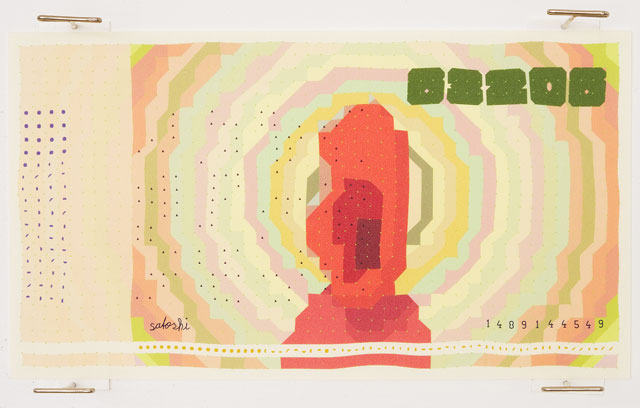
Matthias Dörfelt. Block Bills, 2017 (detail). A series of 64 banknotes generated from the Bitcoin Blockchain. © the artist.
VS: There is a strong graphic sensibility in your work, and the background in communication design really comes to the fore in your Block Bills work. How did that piece evolve?
MD: I have been interested in the blockchain as a technical entity for a while. We have a small group of people at UCLA who run what is called the Art Software Studio. One of our events was an introduction to how blockchain works … From there, I sat down and thought: what would be a good way to make a visual image from individual blocks from the blockchain, and a bank note was almost too simple, but it also made a lot of sense at the same time.
VS: Your design translates many complex ideas into what seems a very simple artefact. I like the sense of ambiguity: the rainbow colours make it appealing, but there is that shadowy figure at the centre of the note. Is this a comment on the more dodgy dealings that go on, thanks to bitcoin’s anonymity?
MD: I tried to draw a hooded figure that suggests either something faceless to hint at that anonymity and dark aspect and also the anonymity of Satoshi, the founder of bitcoin – or the anonymous group who created bitcoin. But bitcoin is not anonymous. It’s fairly anonymous, but not really. It’s one of the mainstream false perceptions, because you still have your key, in every transaction, so you can directly say this key sent money to that key. The hard part is associating that key with a person.
There were two thoughts when I created that figure in the middle, the other was having a creature that opens its mouth, and is screaming – either a gaping mouth that celebrates the ridiculous amounts of money on each bill or squeals in agony about it.
VS: Were you trying to make a political point with this work, or did it just strike you as a fascinating cultural phenomenon?
MD: I have very mixed feelings about it – that’s what I wanted people to get out of it. People celebrate bitcoin as being freed from banks, but that’s not the reality. The reality is the opposite – it’s another uncontrolled marketplace where people trade assets that are not bound to anything real.
VS: It plays into the delusional, escapist side of human nature that the internet exposes so well.
MD: Yes, I think so.
VS. You are not afraid of being controversial – for example, your Donald Trump Twitterbot (@WienerTrump) and Disassembly project (drawings combined with computer generated representations of randomly disassembled weapons. How important is it for your work to comment on or critique the culture around us?
MD: I think human weaknesses and cultural issues are more important to me than political ones. I’ve struggled with that question of whether art can or should be political for a long time. In the end, I concluded that art is a really poor medium for political intervention or change. So if I get drawn to political issues, they just happen naturally to end up being in a piece of work.
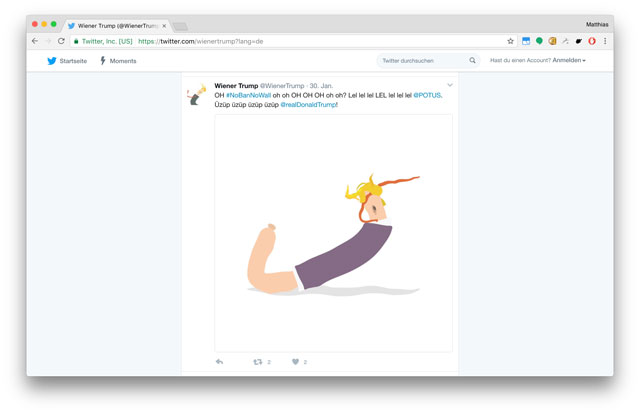
Matthias Dörfelt. Wiener Trump, 2017. A twitter bot (@WienerTrump) that started drawing self-portraits on Inauguration day, January 20th 2017 and will continue to do so every day for one year. Tweets that accompany the drawings are random loud noises that sometimes incorporate a popular hashtag of the day. © the artist.
VS: In some ways you enjoy a greater degree of control as a digital artist – your “artefacts” can be anywhere and everywhere, and their value is not dependent on a physical encounter with “the thing” in a specific, authorised space, such as a gallery. You are also able to sell prints of your work directly, without any sense that the work is diminished in value for being computer generated and easily replicated.
MD: I started the online gallery, my online shop (Mokafolio.de) just two months ago, and the main reason was that it’s just really hard, or I have a hard time finding galleries that are interested in selling my work … Not that I’ve spent a lot of time trying, but there’s this big question: how do you find a gallery? Nobody can give you a good answer to it.
VS: Working in your way exposes the stranglehold that the market exerts on the value of art and who sells it and how artists become celebrated. We are at an interesting point where people are using technology to disrupt that system.
MD: I made this work called the Weird Faces Vending Machine. It was a comment about how value is generated in a gallery space and how my work doesn’t really fit into that system. It was a vending machine where you could swipe your credit card and buy a unique artwork for $3, which of course basically is against all the principles of how value is created from art.
VS: You also curated an online group exhibition in 2015, called: It’s Doing It. How did that come about?
MD: It actually came from the fine art world. It’s my only exhibition or artwork that made it on to Hyperallergic, which is one of the most important cultural websites now for art. It was based on Do It: the Compendium by Hans Ulrich Obrist (a compendium of instructions taken from actual artworks, which allow anyone to recreate them, anywhere in the world). It’s Doing It was directly inspired by that. All the works were computer programs that would make a new image every day for the duration of the show.
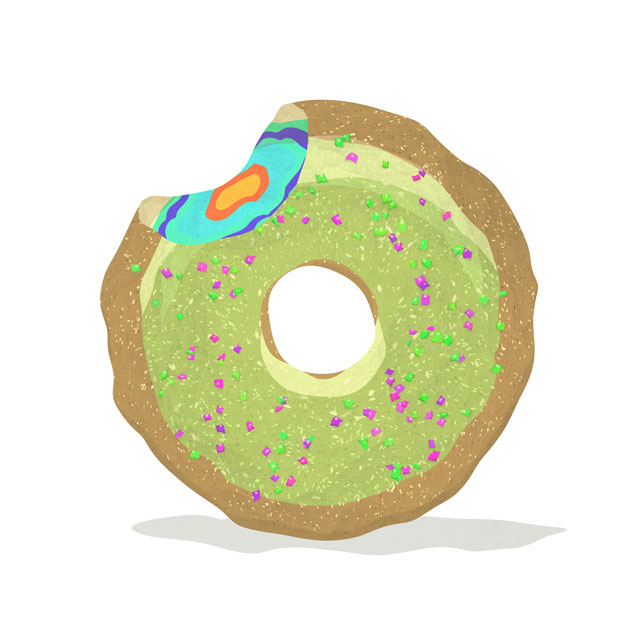
Matthias Dörfelt. Daily Donut, 2015. Dörfelt’s contribution to an online group show he initiated, called It’s Doing It, where computer generated images autonomously updated on a daily basis for 45 days. © the artist.
VS: Given the good response, has there been a temptation to do it again?
MD: Possibly. It’s definitely on my mind to have different kinds of shows. Right now, one thing I’ve been thinking about a lot is a vending machine show: a show with different artists that basically allows you to purchase unique art prints on these machines. It’s a similar idea but putting it in a physical space and giving out physical art prints.
VS: Surely you would charge more than $3?
MD: Probably, but not much more. Maybe $20. If it’s an actual gallery space that wants to have 50% of the money, it would have to be more.
VS: You talk about wanting your work to contribute to shaping our relationship to machines. How do you propose to do that?
MD: I think our relationship to technology in a lot of ways is stuck in the way we thought about technology even before we had computers –like a sewing machine or an industrial machine. We treat computers almost with an attitude that there’s only one expected way in which it works and everything else is a failure. Change is kind of happening with machines such as [Amazon’s] Alexa and Google Home - actual machines that talk to you. It’s only a short step to having machines that won’t have a binary notion to them, but will eventually become more like a living thing. I try to emphasise human expression, failure, and things like that, in my work that I feel will become essential in our attitude, if it is to change towards future machines.
VS: Do you you feel positive about the prospect of integrating our lives more and more with machines?
MD: It’s not a value judgment. I’m very sceptical. I would never put an Amazon or Google machine in my home. But, at the same time, I think it’s going to happen - if not in your home, in your workplace. It’ll happen in the next 10, 20 years.
A lot of my work humanises technology in one way or another. I’m trying to find ways of making the collaboration between myself and the machine more explicit. I make a piece by hand and then the machine adds something to the drawing, and it’s more like an actual collaboration. Another thing I’m exploring is how to bring the things the computer generates into materials that are a bit nicer than drawing with a pen plotter or printing. I am experimenting with drawing on canvas and then painting over it by hand to make real paintings, or paintings that are a real collaboration between me and my computer programs.
VS. Do you ever create artworks entirely without technology?
MD: I definitely draw a lot. Software and coding is one pillar of my work and the other is probably drawing. With most of my work, I feel that - even though it’s made with computer code - it’s basically drawing. I still draw a lot by hand, mainly sketching, and translate the drawings I make by hand into computer code. I haven’t made any finished art works entirely by hand. I think I could see myself doing that in the future, but I think coding and technology will always be part of my art practice probably, at least for a while.